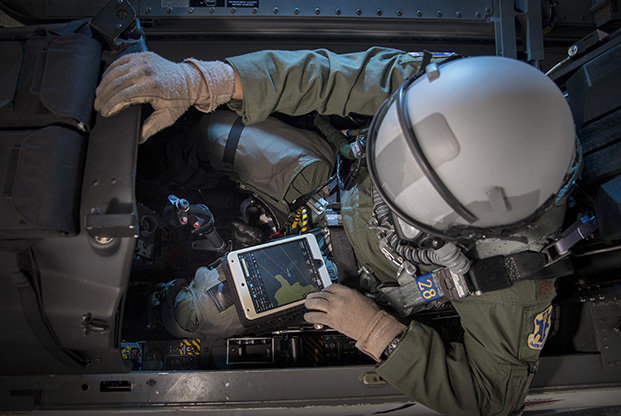
Maj. Earl Arnold runs a preflight check on a T-6 Texan using an electronic flight bag. A tablet-like flight bag is part of 12th Operations Group’s move to enhancing training, efficiency, and accuracy in data recall. Photo: Sean Worrell/USAF
When Defense Department leaders talk about the need for military innovation, they commonly recognize the armed services should be more open to trying things even if they ?may not succeed.
“It’s time to take risks,” Air Force Secretary Heather Wilson said during AFA’s 2018 Air Warfare Symposium. “It’s time to productively fail.”
During the same conference, however, an executive for Alphabet—the umbrella company owning Google—bluntly challenged that notion. The Air Force, argued Milo S. Medin, takes far more risk than any commercial entity ever would.
“This is anything but a risk-averse culture,” Medin said on stage as one of AWS18’s keynote speakers. Being risk averse is not the problem—airmen put their lives on the line in dangerous situations every day. The problem has been a lack of technological innovation. “There’s a price to be paid for lagging behind on innovation, it’s just that the price is not usually paid by the same people who settle for the status quo. That price is going to be paid, nonetheless.”
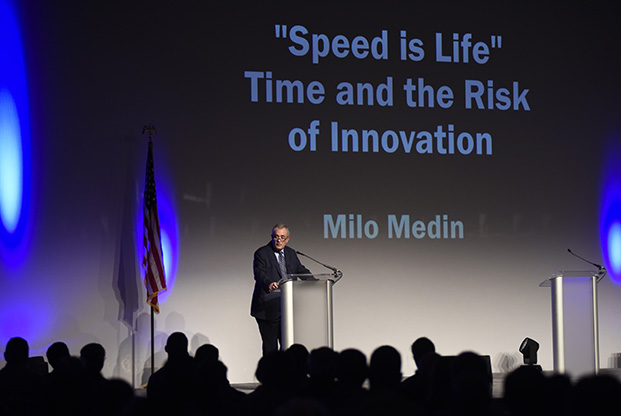
Milo Medin, vice president of Access Service at Alphabet, Inc., says USAF is not a risk-averse culture. To the contrary—the problem is a lack of innovation. Staff photo by Mike Tsukamoto
Medin has most recently been working for Alphabet as vice president of its access services. He has focused on increasing the speed at which networks are fielded and their infrastructural integrity and speeds. Medin is especially peeved with DOD’s requirements-driven strategy, saying it’s “more than inefficient, it’s become dangerous.”
To improve decision-making, USAF has to instill a culture of innovation in airmen from the very beginning. According to Air Education and Training Command boss Lt. Gen. Steven L. Kwast, that culture is “essential” to the success of any society or organization.
_Read this story in our digital issue:
Human nature, at large, is innovation’s biggest challenge, Kwast argued. Any systemic endeavor in that direction, therefore, is prone to bump up against risk aversion and bureaucracy, a reality of any organization.
“Everything that prevents us from being creative is rooted in human nature,” Kwast said. “Bureaucracy is an extension of the human condition. The more people, the more bureaucracy.”
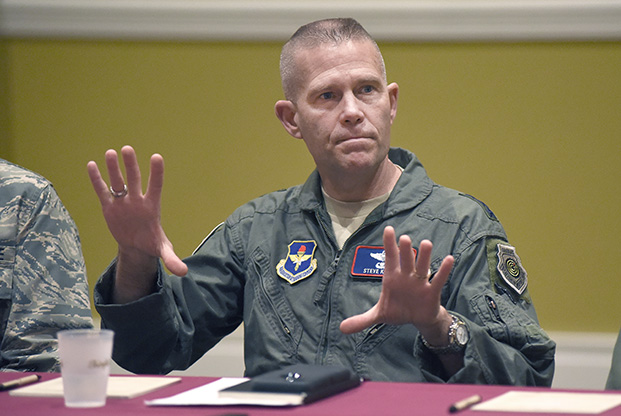
Lt. Gen. Steven Kwast, AETC commander, speaks to the media at the Air Force Associaton’s Air Warfare Symposium in February. Staff photo by Mike Tsukamoto
By design, organizations will have a violent reaction to disruption since it could mean the end of what its leaders hold foundational. To deny or abuse innovation is “a visceral survival mechanism.” Such innovation threatens the “values, the heritages, the hero system, the honor, and the dignity” of its current stakeholders.
Kwast argued that the only way to really push this cultural shift is with a major disruption, one unhampered by the very processes it attempts to cut. Kwast laid out what he thinks is one way to work around the various obstacles—present and inherent—in the Air Force’s current culture. Basically, he said the service has to throw some people outside of its current culture and let them come up with disruptive innovation.
“You don’t ask the pig to slaughter itself,” Kwast put forth. You take a handful of innovators and “hide them from the bureaucracy,” giving them money, freedom, and authority. These are people who yearn to improve processes, who aren’t tied to old ones, who constantly want to figure out new ways to do old things. You give them top cover, knowing if current stakeholders sniff the initiative, they’ll try to “kill it.” And you do this several times over, with different groups of people. Nine out of 10 such initiatives will fail, Kwast allowed.
“But the one that brings you the idea that’s transformational will pay for all the other failures,” he said. After all, Kwast also recognized the Air Force doesn’t teach its airmen any of this at present. But it should, he argued.
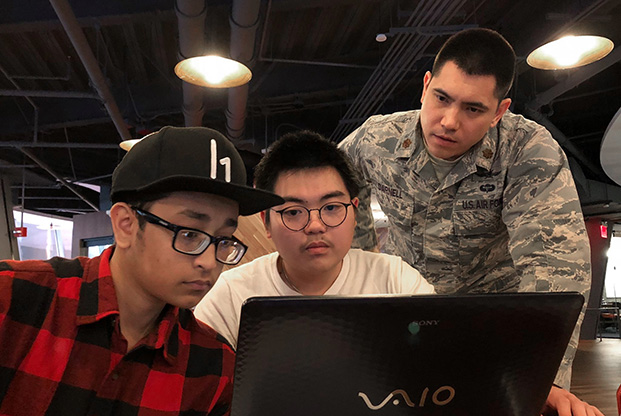
Maj. Barret Darnell (r), assists high school students with hacking challenges at a Hack the Air Force 2.0 event coordinated with the nonprofit organization Code.org. The program revealed 106 Air Force vulnerabilities reported by 27 “hackers” in Belgium, Canada, Latvia, the Netherlands, Sweden, the UK, and the US. Photo: Trevor Tiernan/USAF
Both SECAF Wilson and Chief of Staff Gen. David L. Goldfein have reiterated again and again their backing of an innovative spirit within the service. But thinking outside the box is harder closer to the ground, according to some.
This is especially true in an environment rife with high demand and scant resources.
Just ask Chief Master Sergeant of the Air Force Kaleth O. Wright.
For him, one question from airmen stood out during his first year on the job: “Chief, how can we do more with less?” Speaking at the symposium, Wright said he thinks there’s a better question: How can USAF do less, better, faster, and be more efficient and lethal?
The answer is innovation, he said, adding that culture must be “unleashed.” But innovation has to be unleashed with intention.
Up until now, the Air Force has been ingrained with a culture gyrating between adaptation and innovation, Wright argued. Affixing mirrors to cover a driver’s blind spot is adaptation, he said. Replacing the driver with artificial intelligence, in contrast, is innovation. Ordering detergent from Amazon on a handheld device is adaptation. Walking into one of the company’s new Amazon Go stores and walking out without ever speaking to a cashier—or anyone—is innovation.
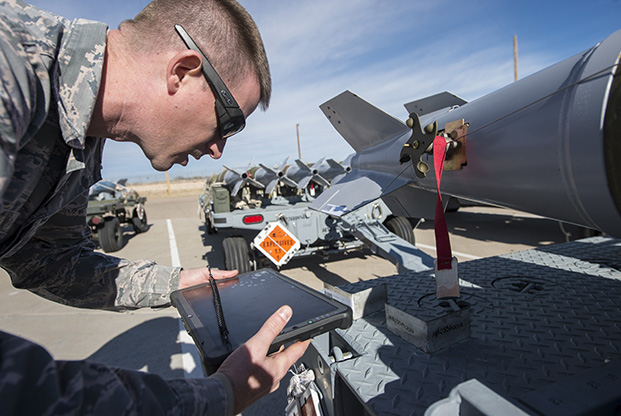
SSgt. Joshua Tobin uses a tablet to scan a barcode at Holloman AFB, N. M. The tablets are in the implementation stage. They enable airmen to input data in real time, significantly cutting down job times. Photo: SrA. Emily Kenney
“Adaptation is about the current fight,” he added. “Innovation is about the future.”
Wright said USAF has to train better than the adversary does, and that has to happen now because of advances near-peer adversaries are making. Today’s airmen may have to take the service under construction today to war in 10 or 15 years. To get the most out of these airmen, the service must allow them to fail, he said.
Echoing the danger to be found in the status quo was another industry executive, Lani Kass of CACI, a Washington, D.C.,-based information systems and solutions outfit with particular focus on national security clients.
Speaking on a panel on transforming digital landscapes within the Pentagon, Kass said she became even more concerned by the “things we don’t know” after the Russians “mucked up” the US election process. Kass currently works as CACI’s senior vice president and corporate strategic advisor.
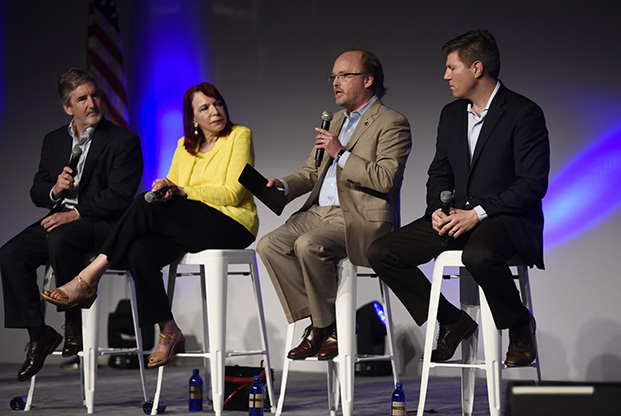
L-r: Chuck Louisell, strategic programs manager at Cisco, Lani Kass, senior vice president at CACI, Lance Spencer, director of global defense at AT&T, and Todd Stiefler, general manager of defense, at GE Aviation Digital, participate in a digital transformation panel discussion at AFA’s symposium in Orlando, Fla. Staff photo by Mike Tsukamoto
In the information domain, Kass said she’s unsure the “perfectly clear” picture USAF sees and acts upon is actually accurate. Does it reflect the truth—or the whims and fancies of an operator who adjusted data to get others to modify their behavior? Despite USAF’s drive to connect all of its nodes and sensors into one holistic pool of information, Kass argues it’s ultimately down to a human operator to act upon data. Even if the military is able to completely lift the fog of war, it comes down to “what humans do with what the machines provide.”
Alphabet’s Medin—who also serves on the Defense Innovation Board—said the pace of global technological innovation is “increasing and more disruption is on the way.”
To really prepare for that potential threat, he said, the Air Force should not be “tolerating the status quo anymore.” That, he concluded, “would be a good start.”
